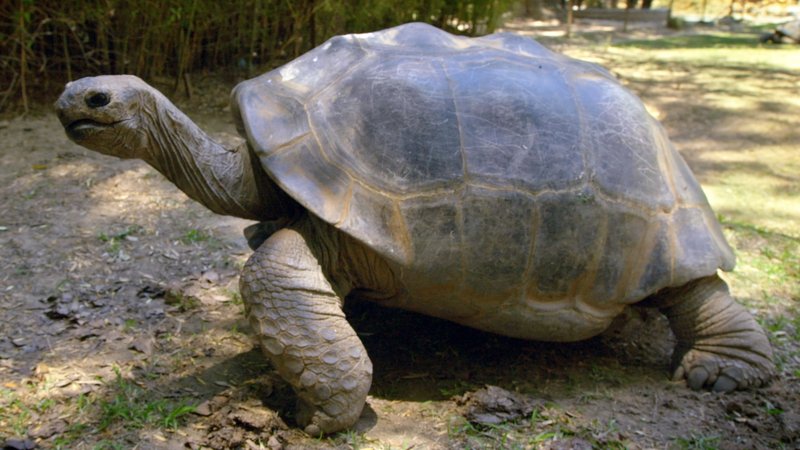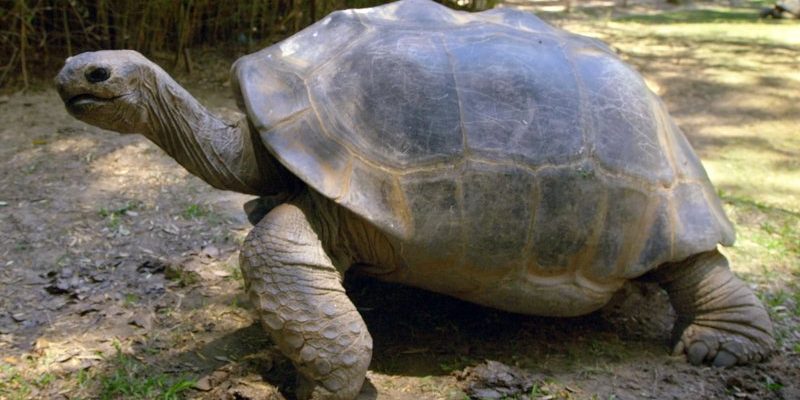
In this article, we’ll explore 10 animals similar to the Aldabra giant tortoise. We’ll look at what makes each one unique and how you can tell them apart from our tortoise friend. So, pour yourself a coffee, and let’s dive into the world of these remarkable creatures!
1. Galápagos Giant Tortoise
You might have heard of the Galápagos giant tortoise, a close relative of the Aldabra giant tortoise. Both species belong to the family Testudinidae and can grow quite large, making them exceptional in the tortoise family. The Galápagos tortoise can weigh over 500 pounds and can live over a century!
One way to spot the difference is through their shell shape. While Aldabra tortoises have more dome-shaped shells, Galápagos tortoises often feature saddle-backed shells, which allow them to stretch their necks and reach higher vegetation. These adaptations show how each species is finely tuned to its habitat.
Their habitats also differ. The Galápagos tortoise roams the volcanic islands of the Galápagos, while the Aldabra tortoise is found in the warm, sandy islands of Seychelles. So, while they may look similar at first glance, their environments have shaped them in distinct ways.
2. Indian Star Tortoise
The Indian star tortoise is another interesting comparison. Although much smaller than the Aldabra giant tortoise, this species stands out due to its striking shell patterns, resembling a starry night. These tortoises typically reach about 10–12 inches in length, making them a compact option for tortoise lovers.
The most notable difference in appearance is their shell. The Indian star tortoise has a beautifully patterned, star-like design on its carapace, which is quite different from the plain, rugged shell of the Aldabra giant tortoise. If you spot a tortoise and it has a starry shell, you’re likely looking at an Indian star tortoise!
Habitat plays a role as well. Indian star tortoises are native to dry regions in India and Sri Lanka, thriving in scrubland areas. This love for arid environments contrasts with the tropical habitats of the Aldabra giant tortoise, emphasizing how diverse tortoise lifestyles can be.
3. Sulcata Tortoise
The Sulcata tortoise, or African spurred tortoise, is another giant in the tortoise world, sharing some features with the Aldabra giant tortoise. These creatures are among the largest land tortoises, reaching sizes comparable to the Aldabra, often exceeding 200 pounds!
One way to distinguish Sulcata tortoises is to look for their distinctive flattened shells with a spurred appearance. Unlike the Aldabra’s more rounded shell, the Sulcata’s shell showcases pronounced spurs on its legs, giving it a unique robust look. Plus, their color ranges from a light tan to a darker brown, adding to their individuality.
Sulcata tortoises hail from the Sahara Desert, where they thrive in hot, dry conditions. This preference sets them apart from the coastal environments favored by Aldabra tortoises, showing how different habitats shape these species.
4. Hermann’s Tortoise
Shifting gears, we meet Hermann’s tortoise, a smaller species that hails from southern Europe. These tortoises typically reach about 6–10 inches in length, making them much smaller than the Aldabra giant tortoise.
In terms of appearance, Hermann’s tortoise has a more compact and rounded shell, often showing a mix of yellow and black patterns. Their size, along with their coloring and the shape of their shell, sets them apart from the larger Aldabra species.
Hermann’s tortoises are often found in warm, dry grasslands and scrub forests. Because of their compact size, they’re popular in the pet trade, contrasting sharply with the Aldabra giant tortoise’s massive presence.
5. Greek Tortoise
The Greek tortoise, also known as the Testudo graeca, is a close cousin to Hermann’s tortoise and shares a similar habitat. These tortoises are small, averaging around 8–10 inches, and have a beautiful, domed shell that displays a range of colors from brown to olive green.
The key feature that distinguishes Greek tortoises from Aldabra giant tortoises is their size and shell markings. Greek tortoises have a more intricate pattern of yellow and brown, making them visually distinct.
Furthermore, they prefer to live in Mediterranean habitats, often basking in the sun on rocky outcrops. This preference for a slightly cooler climate further differentiates them from the warm, tropical environment of the Aldabra giant tortoise.
6. Red-footed Tortoise
The red-footed tortoise, known for its vibrant color and lively personality, is another fascinating relative. These tortoises are smaller, reaching sizes of about 10–15 inches, and can weigh between 10 to 20 pounds. They really pop with their distinct red and yellow markings on their limbs and head.
When comparing this colorful tortoise to the Aldabra giant tortoise, the differences are pretty clear. The red-footed tortoise has a flatter, more colorful shell compared to the robust shell of the Aldabra. They also exhibit a much more lively demeanor, often seen foraging for fruits and veggies in their habitat.
These tortoises are native to the rainforests of South America, preferring damp, lush environments, which contrasts the dry island life of the Aldabra tortoise. Their varied diet also sets them apart, as they enjoy a mix of leaves, fruits, and flowers, showing their adaptability in nature.
7. Aldabra Tortoise (Alder Tortoise’s Close Cousin)
Now, let’s circle back to the Aldabra giant tortoise itself. Yes, it’s similar to its close relatives, but its size and behavior are noteworthy. With a shell length of up to 4 feet and weighing over 500 pounds, it’s hard to overlook!
What really stands out about the Aldabra tortoise is its gentle nature. They have an almost prehistoric look, with a rugged shell and thick limbs that make them appear imposing. Unlike many other tortoises, they can live quite comfortably in colonies, showcasing social behavior that’s rare among their relatives.
When comparing them to other tortoise species, you’ll notice their larger size and more laid-back temperament. Their adaptability to both land and some water environments makes them unique within the tortoise family.
8. Emys Turtles
Though not tortoises, Emys turtles are worth mentioning due to their similarities to their land-bound relatives. Commonly known as pond turtles, they are semi-aquatic and can be found in freshwater habitats throughout Europe and Asia.
What distinguishes Emys turtles from Aldabra tortoises is their more streamlined, flatter bodies, which help them navigate water. They have a softer shell compared to the hard, domed shell of the Aldabra giant tortoise.
In terms of behavior, Emys turtles are more active swimmers, often seen basking on rocks or logs near their water habitats, while Aldabra tortoises are generally more sedentary, grazing slowly on vegetation.
9. Tortuga Tortoise
Also known as the pancake tortoise, the Tortuga tortoise is a unique little creature that resembles a flattened pancake—hence the name! These tortoises usually measure about 6–12 inches, significantly smaller than the Aldabra giant tortoise.
One of the key distinguishing features is their exceptionally flat shell, permitting them to squeeze into rocky crevices for protection. This contrasts starkly with the high-domed shells of Aldabra tortoises, which are built to withstand the pressures of their environment.
Native to the rocky regions of East Africa, pancake tortoises thrive in drier areas than their Aldabra cousins. Their ability to hide effectively from predators sets them apart, showcasing the various adaptations tortoises have developed in response to their habitats.
10. Burmese Star Tortoise
Last but not least, we have the Burmese star tortoise. This stunning tortoise is famous for its star-like shell pattern similar to the Indian star tortoise. However, Burmese star tortoises are often larger, reaching up to 12 inches.
You’ll spot the Burmese star tortoise by its elegant, star-shaped markings, which are visually striking. These tortoises prefer the forests and scrublands of Southeast Asia, making their habitat quite different from the coastal regions of the Aldabra giant tortoise.
Their smaller size compared to Aldabra tortoises allows them to navigate through dense vegetation more easily. Despite these differences, both species share a love of warm climates, highlighting the adaptability of tortoises across regions.
In conclusion, the world of tortoises is as diverse and fascinating as it is beautiful. While the Aldabra giant tortoise is a remarkable creature in its own right, there are numerous other species that share similar traits, each with unique adaptations. Keep an eye out next time you’re exploring nature—there might be more than meets the eye when it comes to these incredible reptiles!

